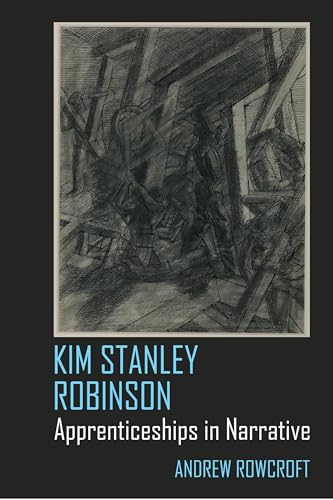KIM STANLEY ROBINSON: APPRENTICESHIPS IN NARRATIVE - Andrew Rowcroft
I am a sucker for anything by or about Kim Stanley Robinson. Since I first read The Gold Coast sometime in the late 1980's or early 90's; I haven't missed any of his books since. So, when I see a book about Robinson, or examining his work, I'm all in.
What I don't like, is reading a research paper, a university-style thesis, posing as a book.
In classic research paper tradition, we begin with an introduction that tells us what we are going to read. Chapter by chapter, taking up nearly 15% of the book's pages, author Andrew Rowcroft tells us what we're going to read in. In detail. With 114 endnotes.
There are six chapters .... well, five chapters and a coda ... dealing with different aspects of Robinson's work. But first ... what does "Apprenticeships in Narrative" even mean?
In his introduction, Rowcroft notes: "This book argues that one of the most striking aspects of Robinson’s fiction is his concern with literary apprenticeship." Still ... "apprenticeship"? Rowcroft understands that this is unusual and has a subheading in his introduction: "Why Call it Apprenticeship?" But he doesn't really answer it.
My reading of apprenticeship is necessarily broad. But it is not my intent to offer a sociology of its formation, or a history of its development. Nor will this book provide a comprehensive account of occupational training in trades or artistic professions, or delve deeply into the pedagogical, occupational, or locational dimensions of apprenticeship theory. (...) In this book, the term captures a regular, informal, non-systematic process of learning the craft of narrative composition in companion with an experienced counterpart, although, importantly, the more experienced individual has often not produced an original work themselves.
This put me off right from the start. If we can't adequately define what we mean by our books title, how can we really have value with what's inside? Rowcroft does get slightly more specific ("(...) this book intends to make clear to readers the sophistication of Robinson’s fiction in relation to the concerns of craft and literary composition" and "The chapter examines each novel as a specific exercise in narrative construction (...The Wild Shore...) consistently articulates the concerns of this study: craft, composition, and apprenticeship.") but it doesn't really help.
The chapters themselves were a bit of a slog. Rowcroft clearly appreciates Robinson's work (as do I) and he's clearly well read beyond Robinson's work, but I often felt I was getting more information about other authors than I was about Robinson's.
But while the chapters didn't provide me with much to enhance my (re)reading of Robinson's work, the coda did.
I'm slightly ashamed to admit, as a former art student, that I never recognized Robinson's appreciation for and inclusion of art in his books until reading this coda. (That's not quite true ... art plays a big role in Shaman: A Novel of the Ice Age, which I greatly appreciated.) Although Rowcroft seems to be a bit obtuse:
It may seem strange, in a book that has focused on the forms of literary apprenticeship that appear in the work of a contemporary author, to turn to the subject of painting. The components are so very different: Robinson’s works are put together out of words, vast assemblages of heterogeneous materials pasted together to form collages of hope and optimism regarding our future. Unlike literature, painting is a given object and immediately invitational. It is canvas, colour, the energy of the brushstroke, the whole rich field of what are non-verbal materials – the ‘fundamental wordlessness of painting’, to quote T.J. Clark, that nevertheless requires commentary and critique. And yet despite the distinctions between painting and page, the former remains an important feature of Robinson’s work; these moments, dispersed across the novels in a fairly unsystematic fashion, have been touched upon throughout this book in a fairly similar regard. This coda brings them together in a satisfactory manner.
To begin with the obvious, Robinson cannot stage painting and it is nowhere present in his work. He can only offer a mimesis of the thing itself (in the Poetics, Aristotle notes that mimesis must be plausible rather than necessarily true). As such, Robinson resurrects an antiquated aesthetic orthodoxy, perhaps a surprising act for a contemporary novelist. Among the oldest terms in literary and artistic theory, mimesis is concerned with imitation and refers to the relationship between an image and its original. Socrates develops this argument, comparing mimesis to a mirror. Imagine, he says, a great craftsperson, able to create everything in the world. When his audience doubt the existence of such an individual, Socrates says that it is quite simple.
I did appreciate being led to recognizing art in Robinson's work.
Were I in college and writing a research paper on Robinson, I would have greatly appreciated a book like this if only for the massive bibliography and some quote opportunities. As a reader of non-fiction and someone who likes to learn something new (especially about someone or something I enjoy), this feels like it's too caught up in trying to be impressive rather than actually delivering something worth knowing.
Looking for a good book? Andrew Rowcroft's Kim Stanley Robinson: Apprenticeships in Narrative takes a deep dive into ... something. But it's likely that only university scholars will find value in the study.
I received a digital copy of this book from the publisher, through Edelweiss, in exchange for an honest review.
2 stars
* * * * * *
Kim Stanley Robinson: Apprenticeships in Narrative
author: Andrew Rowcroft
publisher: Liverpool University Press
ISBN: 9781802075335
hardcover, 184 pages

Comments
Post a Comment